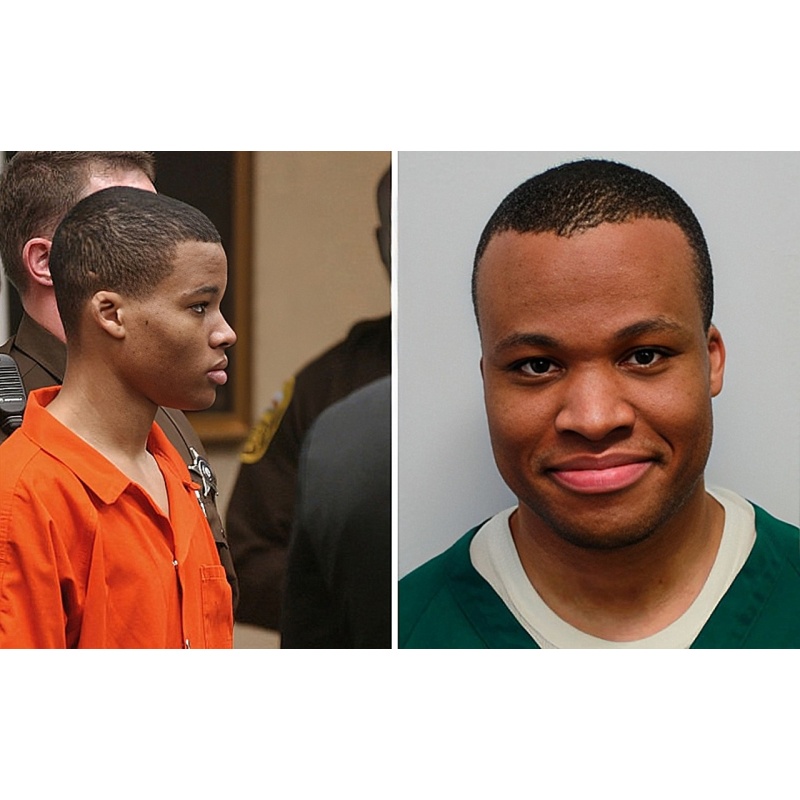LEE BOYD MALVO | With Accomplice John Allen Muhammad, Perpetrated The 2002 D.C. Sniper Attacks | Sentenced To Six Consecutive Life Sentences Without Parole | Autographed Letter Signed
LongfellowSerenade 28
Lee Boyd Malvo, a Jamaican-born American, played a crucial role in the October 2002 sniper attacks in Washington, D.C., alongside his mentor John Allen Muhammad. At the age of 17, Malvo's terrible childhood, which included neglect and abuse, left him exposed to Muhammad's fanatical beliefs and manipulation. Their attacks claimed ten lives and generated serious legal and ethical concerns about juvenile sentencing, notably the propriety of life without parole for juveniles. Malvo's trial indicated that he initially tried to protect Muhammad before admitting to being compelled into conducting the atrocities. His case has inspired ongoing arguments regarding the impact of personal trauma on aggressive behavior, as well as the role of adults in influencing kids. As Malvo serves multiple life sentences, his narrative continues to shape debates about juvenile justice and the societal consequences of violence.
Mind over matter.
Weak minded people are easily influenced.
Strong minded people you can't break their will.
$160.00
- Postage
-
Standard Shipping
$0.00 to United States
Get Additional Rates
- Select Country
- Zip/Post Code
- Quantity
Description
Lee Malvo. Autographed Letter, Signed. Handwritten, Commercial #10 (4.125 × 9.5 envelope). Charleston, WV. January 27, 2025. Content unknown. SEALED.
Introduction
Lee Boyd Malvo is a Jamaican-born American convicted mass murderer who, along with his mentor and accomplice John Allen Muhammad, perpetrated the D.C. sniper attacks in October 2002. At only 17 years old during the attacks, Malvo was both a willing participant and, as later accounts suggest, a deeply troubled youth whose early life experiences and subsequent indoctrination played significant roles in shaping his actions. Today, he is serving multiple life sentences in a Virginia correctional facility, and his case continues to be cited in discussions about juvenile sentencing, indoctrination, and the interplay between personal trauma and violent behavior. Lee Boyd Malvo, 35, married wealthy Sable Noel Knapp, 30, inside Virginia's Red Onion State Prison on March 6, according to The Daily Beast. Knapp is the granddaughter of a wealthy Iowa real estate developer. She is also an outspoken activist who has donated hundred of thousands of dollars to left-wing causes.
Early Life and Background
Family and Childhood
Lee Boyd Malvo was born on February 18, 1985, in Kingston, Jamaica, to Leslie Malvo—a mason—and Una James, a seamstress. His early childhood was marked by instability and abandonment. When Malvo was five, his mother left his father amid suspicions of infidelity. Soon after, Una and Malvo moved to a small mountain town called Endeavour for a period before returning to Kingston and then relocating to St. Martin. During these formative years, Malvo experienced neglect and physical abuse. His mother’s intermittent care, combined with harsh discipline including beatings when he failed to meet her expectations, contributed to his social withdrawal and a growing sense of powerlessness.
Education and Early Signs
While in Jamaica and later Antigua, Malvo attended local schools where he was noted to be a good student and even excelled in athletics, winning a school award in the 100‐meter run. However, despite academic promise, the chronic instability at home and the absence of a consistent paternal figure left him emotionally vulnerable. According to psychiatric experts, these experiences predisposed him to a type of reactive compliance—a way of coping that later made him susceptible to manipulation and indoctrination.
Recruitment and Indoctrination
Encounter with John Allen Muhammad
The turning point in Malvo’s life came when he and his mother encountered John Allen Muhammad in Antigua around 1999. Muhammad, a Gulf War veteran with a troubled past and a penchant for extremist ideology, quickly formed a bond with Malvo. Taking advantage of the boy’s vulnerability and desire for fatherly approval, Muhammad gradually isolated him from his biological mother and began teaching him his radical views. He converted the impressionable teenager to Islam and instilled in him a belief system that would later justify their violent actions. Malvo came to view Muhammad not only as a mentor but as a paternal figure—one who offered him guidance and a sense of belonging that he had long been denied.
Training and Influence
Muhammad subjected Malvo to a rigorous program of military-style training and ideological indoctrination. In addition to physical conditioning and marksmanship practice—such as target shooting at a local firing range using paper targets—Malvo was also exposed to revolutionary literature and, reportedly, to violent video games. Some defense attorneys later argued that this desensitization contributed to his readiness to commit murder, although sociologists have noted that his long history of antisocial behavior (including cruelty to animals) was a more reliable predictor of his later violence. Malvo’s notebooks and drawings, later recovered from his cell, reveal a mind grappling with questions of identity, injustice, and a desire for radical change, albeit expressed through a lens of extreme ideology.
The D.C. Sniper Attacks
Overview of the Attacks
Between February and October 2002, John Allen Muhammad and Lee Boyd Malvo conducted a series of shootings that culminated in the infamous D.C. sniper attacks during a concentrated three‐week period in October 2002. During this time, the pair shot randomly at civilians in the Washington, D.C. metropolitan area—spanning parts of Maryland and Virginia—resulting in 10 fatalities (in the October spree) and several additional deaths and injuries in preliminary shootings across other states. The pair’s modus operandi involved using a modified 1990 Chevrolet Caprice as a “rolling sniper’s nest” from which they could quickly relocate after each attack.
Malvo’s Role
Although John Allen Muhammad was the apparent leader and mastermind, Malvo played a crucial operational role. As the designated shooter in many instances, he executed the killings under Muhammad’s direction. During his trial, Malvo later testified that he had initially claimed to be the sole trigger man for all shootings in an effort to protect Muhammad from the death penalty—a claim he later recanted, stating that he had been manipulated by Muhammad’s coercive influence. His testimony also revealed disturbing details of their planned phases of terror, which included extortion schemes and even more elaborate plots involving bombs and the recruitment of other vulnerable youths for future acts of violence.
The Planned Phases of Violence
Malvo’s account of the pair’s plans—as detailed during trial testimony—outlined an elaborate three-phase strategy:
Phase One: Muhammad intended to kill six white people per day for 30 days, systematically moving from one location to another to avoid capture. However, heavy traffic and other practical difficulties disrupted these plans.
Phase Two: This phase was designed to unfold in Baltimore and involved the planned murder of a pregnant woman, followed by the targeted killing of a police officer and the detonation of bombs at the officer’s funeral to further terrorize law enforcement.
Phase Three: The final phase aimed to extort millions from the government to finance a plan to recruit and indoctrinate orphaned youth, training them as militants for further acts of violence across the country.
These revelations underscored the cold, calculated nature of their operations and the extent to which Malvo was involved in and influenced by Muhammad’s extremist vision.
Trial, Sentencing, and Legal Developments
The Legal Process
Following their arrest on October 24, 2002, both Muhammad and Malvo faced extensive legal proceedings in multiple jurisdictions. Malvo was tried in Virginia and Maryland. Given his status as a juvenile at the time of the crimes, his case raised significant legal questions regarding the constitutionality of sentencing minors to life without parole. During his trial, Malvo’s defense argued that he had been under the complete control of Muhammad and was a victim of manipulation. Despite these arguments, a Virginia jury convicted him on multiple counts of capital murder. In 2003, Malvo was sentenced to life in prison without the possibility of parole, though his sentence has been the subject of ongoing legal appeals in light of evolving standards regarding juvenile sentencing.
Appeals and Post-Sentencing Developments
Over the years, Malvo’s legal team has pursued multiple appeals. In May 2017, a federal district court judge in Virginia overturned his life-without-parole sentence on the grounds that it violated constitutional protections for juvenile offenders (as established in cases like Miller v. Alabama). However, subsequent rulings in Maryland and by various courts have led to continued legal debates over his sentence. More recently, developments have included orders for resentencing in Maryland to comply with Supreme Court rulings that life without parole for juvenile offenders is unconstitutional, as well as discussions regarding his eligibility for parole under changed Virginia law after 20 years of incarceration. As of mid-2024, Malvo has been transferred from Virginia’s supermax prison to a lower-security facility, signaling further adjustments in his incarceration status.
Testimony and Remorse
During the trial, Malvo’s testimony was pivotal. Although he initially tried to shift full responsibility onto Muhammad by claiming he had been the sole trigger man, further questioning and subsequent counseling led him to admit that he had deliberately misrepresented his role in order to spare Muhammad from a death sentence. In later interviews, Malvo expressed remorse, referring to himself as a "monster" and acknowledging the profound harm caused by his actions. He also claimed that Muhammad had sexually abused him, a statement that has contributed to ongoing discussions about his vulnerability and the nature of his relationship with his accomplice.
Impact and Legacy
Societal and Legal Impact
The D.C. sniper attacks, with Malvo as a central figure, had a profound impact on the national consciousness. The randomness of the violence, combined with the shocking fact that a 17‐year-old was involved in such a high‐profile case, spurred debates over gun control, juvenile justice, and the responsibilities of adult mentors in shaping vulnerable youths. Malvo’s case has since been cited in discussions about the ethics and legality of sentencing juveniles to life without parole, and his appeals continue to influence legal reforms regarding juvenile offenders in capital cases.
Media Portrayals and Cultural References
Lee Boyd Malvo’s story has been explored in multiple films, documentaries, and television portrayals. He has been depicted in productions such as the TV film D.C. Sniper: 23 Days of Fear, the film Blue Caprice, and the series I, Sniper. These portrayals often focus on the disturbing dynamic between Malvo and Muhammad and the transformation of a troubled youth into a key player in a mass murder spree. Such media representations have contributed to ongoing public debates about the causes of violent behavior, the effects of abuse and indoctrination, and the societal responsibility to protect vulnerable children.
Conclusion
Lee Boyd Malvo’s life and crimes are emblematic of a tragic confluence of personal vulnerability, abusive upbringing, and the destructive influence of an extremist mentor. Born into poverty and subjected to repeated abandonment and abuse, Malvo’s early life left him susceptible to the manipulative influence of John Allen Muhammad. The D.C. sniper attacks not only terrorized the Washington metropolitan area in 2002 but also raised difficult questions about juvenile culpability, the ethics of life sentencing for minors, and the ways in which a young person’s background can be both a mitigating and aggravating factor in the justice system. As ongoing legal appeals and resentencing efforts continue to shape his future, Malvo’s case remains a powerful reminder of the complex interplay between environment, ideology, and the capacity for violence.
VIDEO: The D.C. Snipers: A Man and a Boy (Tragedy Documentary) | Real Stories | https://youtu.be/S3MYY4SN8ts
VIDEO: The Road to Becoming A Teenage Murderer | I, Sniper: The Washington Killers | Channel 4 | https://youtu.be/mVEQ6sJlSRU
Archiving Protocol:
• Handled with White Gloves ab initio
• Photo Pages/Sheet Protectors: Heavyweight Clear Sheet Protectors, Acid Free & Archival Safe, 8.5 × 11, Top Load
• White Backing Board – Acid Free
Shipping/Packaging: Rigid Mailer 9.5 × 12.5. White, self-seal, stay-flat, Kraft cardboard, no bend. Each rigid mailer is made of heavy cardboard, which has strong resistance to bending and tearing. Thicker than the USPS mailers. Shipping cost never more than it absolutely has to be to get it from me to you.
Payments & Returns
- Payment Methods
- PayPal, Money Order
Postage & Shipping
- Item Location
- 49858, Michigan, United States
- Ships To
- Worldwide
- Pick-ups
- No pick-ups
- Shipping Instructions
- Shipping costs to international destinations will be applied to this auction. Please contact us if you have any questions about shipping to your location.
- Returns Accepted
- No




-800x800.jpg)
-800x800.jpg)

-500x500.jpg)

-500x500.jpg)
